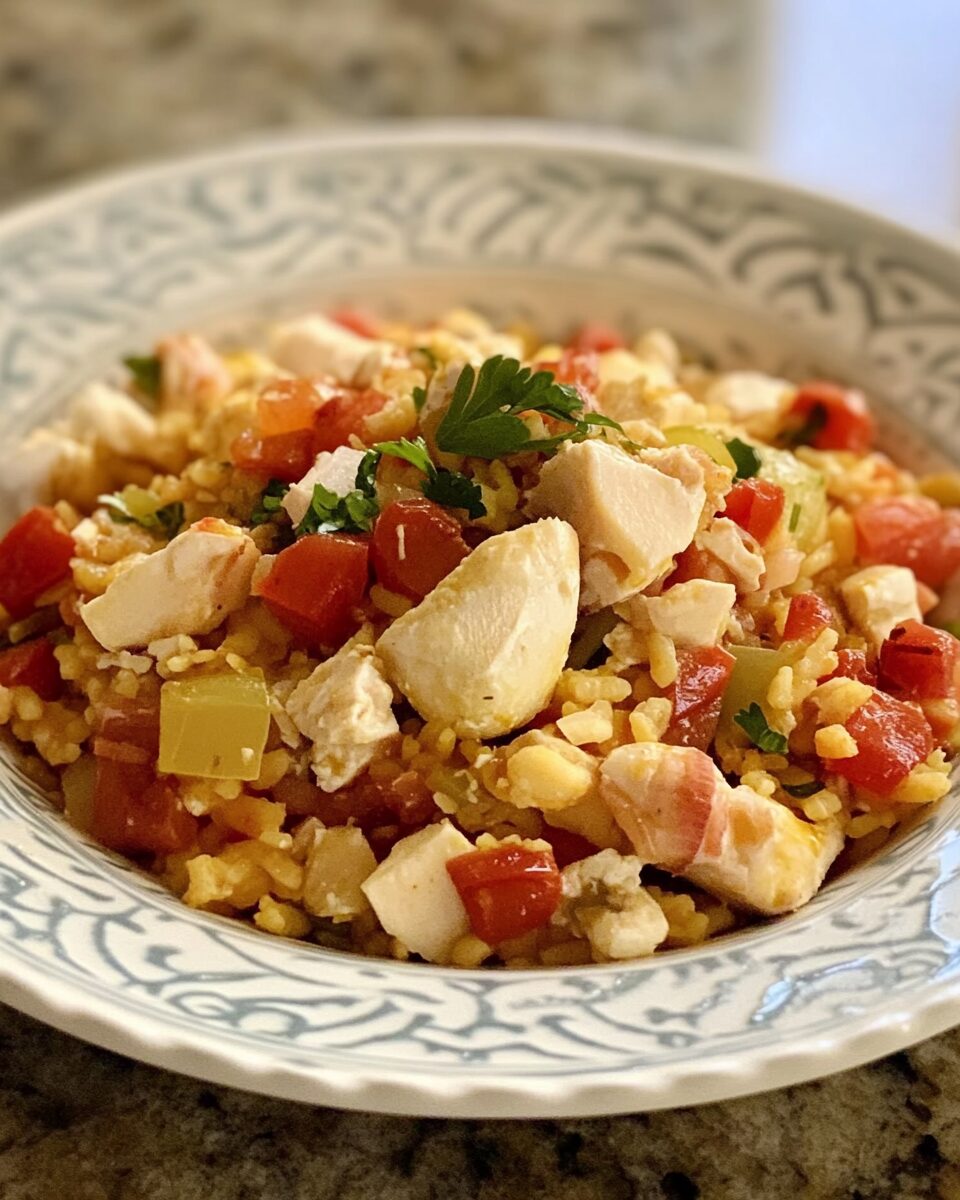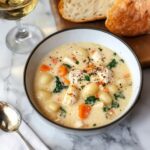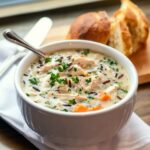North African Paella is a bold and flavorful twist on the traditional Spanish dish, featuring aromatic spices, tender chicken, seafood, and vegetables. This dish is a fusion of flavors from the Mediterranean and North African regions, offering a delightful combination of saffron, cumin, paprika, and turmeric. Served over rice, this hearty one-pot meal is a vibrant and satisfying dish, perfect for family gatherings or special occasions.
Full Recipe:
Ingredients
- 2 tablespoons olive oil
- 1 pound chicken thighs, bone-in and skinless
- 1/2 pound shrimp, peeled and deveined
- 1/2 pound mussels, cleaned and de-shelled
- 1 cup Arborio rice or short-grain rice
- 1 medium onion, chopped
- 2 cloves garlic, minced
- 1 red bell pepper, chopped
- 1 teaspoon paprika
- 1 teaspoon ground cumin
- 1/2 teaspoon ground turmeric
- 1/2 teaspoon saffron threads
- 3 cups chicken broth
- 1 can (14.5 ounces) diced tomatoes, drained
- 1 cup frozen peas
- Salt and pepper, to taste
- Fresh cilantro, for garnish
- Lemon wedges, for serving
Directions
- Heat olive oil in a large paella pan or a large skillet over medium-high heat. Add chicken thighs and cook until browned on both sides, about 8-10 minutes. Remove the chicken and set aside.
- In the same pan, add shrimp and mussels. Cook for about 3-5 minutes until the shrimp are pink and the mussels open up. Remove seafood and set aside.
- Add chopped onion, garlic, and red bell pepper to the pan, cooking until softened, about 3 minutes.
- Stir in paprika, cumin, turmeric, and saffron. Cook for another 1-2 minutes, allowing the spices to bloom and release their fragrances.
- Add Arborio rice, stirring to coat the rice with the spices.
- Pour in chicken broth and diced tomatoes, stirring to combine. Bring the mixture to a boil, then reduce the heat to low. Cover and simmer for 15-20 minutes until the rice is cooked and liquid is absorbed.
- Add the cooked chicken, shrimp, mussels, and frozen peas to the rice. Stir gently to combine, and cook for another 5 minutes to heat everything through.
- Garnish with fresh cilantro and serve with lemon wedges for an added citrus kick.
Nutrients
- Calories: 460 kcal
- Protein: 38g
- Fat: 14g
- Carbohydrates: 50g
- Fiber: 4g
- Sugar: 7g
- Sodium: 800mg
Historical and Cultural Significance of Paella
Paella originated in the region of Valencia in Spain and was traditionally made with chicken, rabbit, and various local vegetables, simmered with rice in a large, shallow pan. The origins of the dish date back to the 19th century when it was primarily enjoyed by rural farmworkers. Over time, the dish evolved as it spread across Spain, incorporating seafood in coastal regions and diverse ingredients in other areas. Paella’s evolution reflects the culinary diversity found within Spain, where the dish has been adapted to suit different tastes and available ingredients.
The North African version of paella carries the same sense of communal eating that the Spanish dish embodies. While Spain’s paella is often served with seafood or land-based meats, the North African variation allows for flexibility, adding ingredients like shrimp, mussels, and chicken, along with a blend of spices that elevate the flavor profile. This fusion of Spanish and North African culinary traditions highlights the shared history of both regions and their interconnected trade routes, which brought together spices, grains, and other ingredients that shaped their food cultures.
Flavors of North African Paella
What makes North African Paella stand out is the complex layering of flavors. Spices like saffron, cumin, turmeric, and paprika are the backbone of the dish. Saffron, with its delicate floral notes, imparts a luxurious golden color to the rice, which is one of the dish’s most striking features. The cumin and turmeric bring earthiness and warmth, while paprika adds a smokiness and slight heat that is characteristic of many North African dishes.
This combination of spices is a hallmark of Moroccan cuisine, where spices are used to build flavor and depth without overwhelming the palate. These spices are often paired with dried fruits, which add a touch of sweetness to balance out the savory and spicy elements. In North African Paella, however, the main flavor comes from the earthy spices and the tender proteins like chicken and seafood. The fresh vegetables, such as onions and bell peppers, provide a crunchy contrast and help to round out the dish.
The seafood components in North African Paella—typically shrimp and mussels—add a briny freshness to the dish. The shrimp contribute a natural sweetness that contrasts beautifully with the spices, while the mussels infuse the rice with a deep, umami-rich flavor. Paella is also a versatile dish, with the ability to include other types of seafood, such as squid or clams, depending on what is available or preferred.
Cooking Techniques of North African Paella
The traditional Spanish paella is cooked in a wide, shallow pan that allows the rice to cook evenly and absorb all the flavors. This same technique is used in North African Paella, though it can also be made in a large, deep skillet or a heavy-bottomed pot. The key to success is the cooking method, which involves layering the rice and cooking it at a low simmer to allow the flavors to infuse into the rice and proteins.
One of the most important aspects of cooking paella is the development of the socarrat, the crispy, caramelized layer of rice at the bottom of the pan. This layer is considered a delicacy and adds both texture and flavor to the dish. Achieving a perfect socarrat requires careful attention to the heat and cooking time. Paella should be cooked slowly, and once the liquid has been absorbed, the heat is increased slightly to create the crispy bottom layer.
Another technique used in North African Paella is the addition of seafood and meat at different stages of cooking. The seafood, such as shrimp and mussels, is often added towards the end of cooking to prevent overcooking. Chicken, on the other hand, may be cooked longer to allow it to become tender and infuse the rice with its flavors. The layering of these ingredients ensures that each bite offers a combination of textures and flavors, from the tender chicken to the plump shrimp and the soft, flavorful rice.
Pairing North African Paella with Side Dishes
North African Paella is a hearty dish on its own, but pairing it with a few complementary side dishes can elevate the meal even further. A light, refreshing salad with ingredients like tomatoes, cucumbers, and olives is the perfect accompaniment to balance out the richness of the paella. The fresh, crisp vegetables and tangy olives help to cut through the spiced rice and tender meat, offering a contrast that refreshes the palate.
Another great side dish to pair with North African Paella is warm, crusty bread. In Morocco and Tunisia, flatbreads like khobz are commonly served with stews and rice dishes, and they are perfect for soaking up the flavorful sauce. Bread can also be used to scoop up the rice, making the meal more interactive and enjoyable.
To complete the meal, consider serving a light dessert that complements the spices of the paella. A simple fruit salad with citrus fruits like oranges and pomegranates can provide a refreshing finish to the meal. Alternatively, Moroccan pastries like baklava, with its layers of flaky dough and sweet honey syrup, would also pair well with the warm spices in the paella.
Nutritional Benefits of North African Paella
North African Paella is a nutrient-rich meal that combines lean proteins, complex carbohydrates, and a variety of vitamins and minerals. The chicken provides a high-quality source of protein, while the shrimp and mussels contribute additional protein and heart-healthy omega-3 fatty acids. Seafood is also rich in iodine and selenium, which are essential for thyroid health and immune function.
The vegetables in the paella, including bell peppers, onions, and peas, provide fiber, antioxidants, and vitamins like vitamin C and vitamin A. The saffron, cumin, and turmeric are not only responsible for the dish’s vibrant flavor but also have anti-inflammatory properties, promoting overall health and wellness. The dish’s rich array of spices also supports digestion and can help to regulate blood sugar levels.
Because paella is often served with rice, the dish provides a good source of carbohydrates that give the body energy. However, depending on the type of rice used, paella can be adjusted to be more or less nutrient-dense. Using brown rice instead of white rice would increase the fiber content and add a nutty flavor to the dish.
Variations of North African Paella
While the traditional North African Paella contains chicken and seafood, this dish can be easily adapted to suit different tastes and dietary preferences. For a more robust flavor, you can add lamb or beef to the paella, bringing a new richness to the dish. Some versions of paella incorporate vegetables like eggplant, zucchini, and carrots, which add more texture and nutrients to the dish.
Vegetarians can enjoy a plant-based paella by using a variety of vegetables, beans, and even tofu or tempeh for protein. This variation offers all the bold flavors and textures of the traditional dish while being more accessible to those who do not eat meat or seafood.
For those who prefer a spicier version of the dish, additional chili peppers or harissa (a fiery North African chili paste) can be added to provide a kick. This variation allows for customization based on personal preference, making North African Paella a highly adaptable dish.
Conclusion
North African Paella is an exceptional dish that combines the flavors of Spain and North Africa to create a vibrant, one-pot meal that’s perfect for any occasion. The tender chicken, succulent seafood, and spiced rice come together in a beautifully balanced dish that celebrates the complexity of North African cuisine. Whether you’re cooking for a family dinner, a special celebration, or simply craving something flavorful and satisfying, North African Paella offers a perfect solution.






